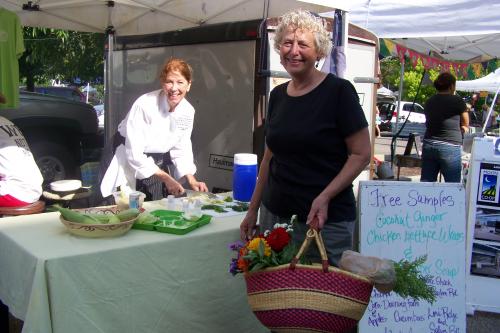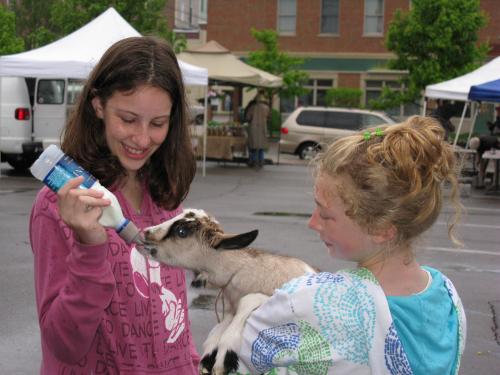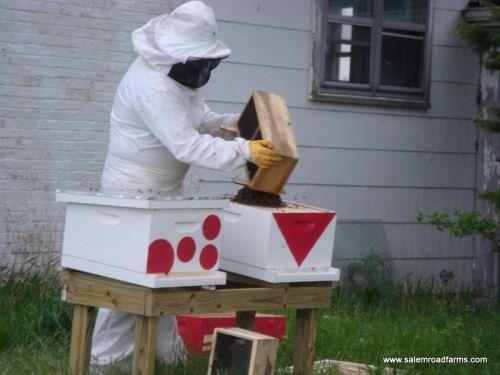Karen Fitch walks by as Barbara Hughes is preparing Coconut Ginger Chicken Letuce Wraps and cucumber soup. See recipe page
Category: Uncategorized (Page 4 of 12)
See article in Mother Earth News: http://www.motherearthnews.com/real-food/save-money-on-groceries.aspx
Organic Fruits and Veggies: Store-Bought vs. Home-Preserved
Whether you can or freeze the produce that you buy in bulk, you’re almost always going to save money compared to buying in supermarkets.
The chart below summarizes the costs of canning or freezing some typical items versus what you’d likely pay for them in a supermarket. In some instances, you can save more than 75 percent by canning — and more than 80 percent by freezing — produce purchased in bulk. Don’t forget to account for waste, such as tomato cores or corn cobs, if you do your own calculations for other fruits and veggies.
(All 16 oz quanties)
Produce Fresh Bulk Cost Home Canned Store Canned Home Frozen Store Frozen
green beans$1.00/lb $1.00 $1.31 $1.00 $1.99-$4.62
sweet corn $2.00/dz $0.83 $1.31 $0.83 $1.99-$4.62
shell peas $2.00/lb $6.00 $1.31 $6.00 $1.99-$4.62
whole tomatoes $1.00/lb$1.50 $1.31-$1.84 $1.50 N/A
beets $1.00/lb $1.00 $1.31 $1.00 N/A
broccoli $1.50/lb N/A N/A $1.50 $2.29
spinach $4.00/lb N/A N/A $4.00 $4.62-$5.74
pears $1.00/lb $1.00 $2.19 $0.50 $3.59-$4.78
blueberries$0.50/lb $0.50 $2.19 $0.50 $3.59-$4.78
peaches $1.00/lb $1.00 $1.99-$2.59 $1.00 $3.59
“Home” prices are based on reports from co-author Roberta Bailey and the Maine Organic Farmers and Gardeners Association.
“Store” prices are for organic brands sold at Hannaford supermarkets and health food stores.
This is the most exciting announcement we have ever made:
On August 3, 2010, MOON Co-op signed a lease to open the
MOON Market at Tollgate Mall in Oxford. There will be plenty
of free parking adjacent to your store, which fronts a beautifully
landscaped courtyard between Capitol Dry Cleaner and Little
Caesar’s Pizza. It is the former location of Mocha Joe’s
Restaurant.
Please attend the Lease Signing Celebration
Time: Sunday, August 15, 3-5 P.M.
Location: At the store site, 512 S. Locust Street.
Current and propective MOON Co-op member-owners are invited.
Bring your own chair or blanket.
Please excuse the mess!
Securing this lease is the result of literally hundreds of hours of work
and it was worth it because the site and lease conditions have many
big advantages.
Tim Goldner is your landlord and has been wonderful through the
negotiation process.
There will be an extensive press release in the Oxford Press,
August 6th.
______________________________________________________________________________________________
What MOON needs from MOON Member-owners:
LOAN!
The member-loan campaign will be launched Aug 15.
The financial foundation of the store is loans from Member
Loaners. We need $300,000 – $350,000 from member loans.
We already have $100,000 deposited loans.
Calls to members will start in Mid-August. To make a loan,
call Rebekah 520-1915 or Bernadette at 523-3990 or
email: bxu@mooncoop.com
RECRUIT!
We all know people who said “I’ll join when the store is a
reality.” Well…now is the time to recruit those friends and
neighbors.
Currently, 506 Oxford-area households are member-owners
of the store. Interest in MOON is growing daily.
SPREAD THE WORD!
Members must spread the word about the location.
The approximate opening is Late Winter 2011 and we hope
to have 600-700 member owners by then.
“SHOP THE MOON MARKET FIRST” is now our motto.
For the store to survive we must do most of your shopping
at the MOON Market, while going to other stores only for the
few items we are unable to get at the Market.
Your store will be small but carefully stocked to meet your
weekly shopping needs, based on customers preferences.
Remember, your store will be open to the public so encourage
everyone to shop there.
Take the product request survey at www.mooncoop.com
TALK TO DECISION MAKERS: Let Oxford City Council
members and members of the Community Improvement
Corp (CIC) know how important your co-op is to your family and
the community. They will be deciding on our application for
a $245,000 low interest loan for your co-op. The application
amount is based on job creation ratio.
MOON is creating new jobs. We are asking for a significantly
higher amount than any prior applicant so it is important the
the CIC members understand how important this is.
Community Improvement Corporation
(names in bold are the review subcommittee)
Alan Kyger akyger@cityofoxford.org Executive Director.
Ex-Officio
Kevin McKeehan kmckeehan@cityofoxford.org
City Council Rep
Joseph Newlin jnewlin@cityofoxford.org
Treasurer
J.C. Rupel oxfordcopy@hotmail.com
President-At-Large
Jim Clawson julie@hoteldevelopment.net Vice President –
Kate Currie kcurrie@cityofoxford.org City Council Rep
Richard Daniels radaniels45@yahoo.com Chamber of Commerce Rep
Mike Davis davism@talawanda.org Talawanda Rep
Douglas R. Elliott Jr. delliott@cityofoxford.org City Manager – Ex-Officio
Larry Frimerman larryfrimerman@yahoo.com Oxford Township Rep
Brian Hehemann At-Large
David Prytherch prythedl@muohio.edu Planning Commission Rep
Steve Snyder snydersd@muohio.edu Miami University
Steve McHugh CIC Attorney-Ex-Officio
City council
Bob Blackburn, bblackburn@cityofoxford.org
Kenneth Bogard, Vice-Mayor kbogard@cityofoxford.org
Kate Currie, kcurrie@cityofoxford.org
John Harman, johnharman@usa.net
Richard Keebler, Mayor, rkeebler@cityofoxford.org
Kevin McKeehan, kmckeehan@cityofoxford.org
Greig Rutherford, grutherford@cityofoxford.org
See you at our Store!
The MOON co-op Board
On the Cincy Locavore listserv I spotted this question:
Hey Everyone,
I put a post on our blog today about buying local over organic when you have to choose. I thought folks on this list might be interested, and I wonder if people agree with my current assessment.
Here is the link.
Any comments – here or on the blog – would be great!
Thanks,
Gavin DeVore Leonard
And here is my answer:
I prefer local over Organic and I am one of those growers who is not certified Organic but grows that way. But by no means are all the local growers growing Organically, even if they say they are. My farm was certified organic by OEFFA for over 6 years back before the USDA took over. I learned an awful lot about organic farm management and Organic growing during that time and find it to be vitally important to keep growing that way. But I also know that before I went through the process of transitioning to Organic and Organic Certification I would tell my customers when asked, “Yes we grow Organically” because I really thought how I was growing was Organic. I was dead wrong. I found out that Organic really doesn’t have much to do with avoiding pesticides and fertilizers. As a matter of fact both are used on well managed Organic farms certified or not. What I did fond out is Organic is all about soil management and it is this facet of Organic farm management that puts us apart from the conventional farmers. I also learned that it takes around 7 to 15 years to get one’s soils healthy after decades of abuse from conventional salt based fertilizers and pesticides, not the 3 year transition period used by the USDA (which is an arbitrary number that was used by many pre USDA Organic certifiers that would allow some recovery by the soils but not keep farmers waiting so long to get certified that it would make any economical sense to 99% of them).
Most people, including many farmers, believe that Organic farming is all about avoiding certain inputs (pesticides and fertilizers and hormones for livestock). They simply do not understand the processes that must happen to make one’s farm truly Organic and thus see no problem with using a bit of RoundUp on “really bad” weeds or some sort of chemical and very toxic insecticide like Sevin dust because they think without it they will lose their crop(s). My point is that a lot of the farmers/growers at farmers markets who are not certified Organic are also not growing Organically, even though they say they are and may believe they really are (as I used to as well until I found out I was anything but Organic at the time) so do not fool yourselves into thinking that all local farm are organic farms. Yes there are those of us who really are Organic and no longer feel the need to have papers that say we are and I do know a few farmers who have never gone through Organic cert. but are indeed deeply Organic in how they grow (generally because they worked on a certified Organic farm for a few years before going out on their own or because they are the type of person who loves to do research and have taken the time to learn what Organic farm management entails). But I find from talking to farmers at markets that most are at best quasi Organic, especially the livestock people who rarely feed Organic feed and thus are feeding GMO’s to their stock (which in my mind is NOT Organic and for me is a deal breaker).
But all that said I would rather support quasi Organic farms and conventional farms that are local to me than buying Organic from who knows where
That’s my 2¢
Can Pesticides on Food Lead to ADHD?
Posted By JoWehage : Head Operations Ego On May 20, 2010 @ 5:30 am In All Articles, Featured,
Food & Nutrition, Health & Wellness | 1 Comment
Just when I thought I’d shift my focus from organic and conventional produce a new study in the
Journal Pediatrics associates exposure to pesticides and cases of ADHD (attentiondeficit/
hyperactivity disorder) in the U.S. and Canada. Once again my friends, my tried and true
blueberry may be an accomplice in horrendous acts.
According to the Centers for Disease Control and Prevention, the diagnosis of ADHD has risen 3%
each year since 1997. More and more research is suggesting ongoing chemical influence and
environmental elements (like video games and flashing images on the TV) may be factors in the
rise of attention problems.
For the most recent study University of Montreal and Harvard University researchers examined
the level of pesticide residue in over a thousand children from ages 8 to 15. Those with the
highest levels of dialkyl phosphates (broken down byproducts of organophosphate pesticides)
had a 35% increased chance of developing ADHD with every tenfold increase in urinary
concentration.
A striking effect was also seen at lower levels: kids who had any detectable, above-average level
of the most common pesticide metabolite in their urine were twice as likely as those with
undetectable levels to record ADHD symptoms.
The study, led by Maryse Bourchard, is the first to focus on organophosphate pesticides as a
contributor to ADHD. Organophosphates are known to cause damage to the nerve connections in
the brain, which is exactly how they kill agricultural pests.
While researches acknowledge it is easier to uncover an association between pesticides and
ADHD than a direct causal link the results clearly call for immediate further study.
Sadly for me, according to the U.S. Pesticide Residue Program report, organophosphates were
detected in 28% of frozen blueberries and in 19% of celery samples tested. How dangerous are
those levels to you and your kids? Do you want to wait to find out?
As the search for more answers and data continues Bourchard suggests that parents avoid using
bug sprays in the house and feeding kids organically grown fruits and vegetables.
I suggest you print out the Environmental Working Group’s wallet guide [1]mentioned in our 12
Most Toxic Fruits & Veggies [2]post for everyone you know. Sources there claim that you can
avoid 80% of pesticides by knowing the 12 most toxic produce items and either buying organic or
choosing another option.
If you’re in Cincinnati or surrounding areas you may want to take a look at our Produce Price
Comparison by Store [3]for updated data from our post, Where to Buy Your Produce [4].
In the meantime I’m working on more applications for avocados, pineapples and mangos, some
of the least contaminated produce options.
Article printed from Healthy Alter Ego : The Health & Wellness Source You’ve Been Searching For:
http://www.healthyalterego.com
URL to article: http://www.healthyalterego.com/index.php/2010/05/can-pesticideson-
food-lead-to-adhd/
URLs in this post:
[1] wallet guide : http://www.foodnews.org/walletguide.php
[2] 12 Most Toxic Fruits & Veggies : http://www.healthyalterego.com/index.php/2010/05
/the-12-most-toxic-fruits-veggies/
[3] Produce Price Comparison by Store : http://www.healthyalterego.com/wp-content
/uploads/2010/05/Produce-Comparisons-by-Store-May-2010.pdf
[4] Where to Buy Your Produce: http://www.healthyalterego.com/index.php/2010/05
/where-to-buy-your-produce/
GREEN SCREEN—Thursday, June, 24th 2010
A free environmental film from the Oxford I.C.C.W.G.
Green Screen presents films about the science, art, politics and spirituality of the natural environment. Presented FREE at 7:00p.m. at the Oxford Community Arts Center.
THURSDAY, JUNE, 24th 7p.m.
NICOTINE BEES
All over the world, at the same time, with the same bizarre behaviors bees simply leave their precious honey and young behind. They don’t come home. This movie gets to the truth about why the honey bees of the world are in big trouble, and why our food supply is in trouble with them. Filmed on 3 continents to find out the reason bees are in catastrophic decline – and why many people don’t want the real story to be told. With the continuing bee collapse one third of our food supply is at risk – despite the clear-cut scientific data news reports continue to call the phenomenon “mysterious.” We think this crisis is not mysterious. Nicotine Bees is ready to show what has happened.
53 min.
Dear Friends:
Please join us* for a story swap open house tomorrow afternoon 3:30 – 4:30 p.m. May 27 in Shideler 112. (Shideler is at the corner of Patterson and Spring Streets and is featured as building 125 on the map: http://www.miami.muohio.edu/about-miami/visiting-miami/oxford-campus-map…)
We will tell tales of the following:
–Six Word Memoirs
–Brief Digital Stories of our fieldtrips and excursions to Rumpke Landfill and a canoe trip along the Great Miami River (guided by GMR Riversports) –and informal informational anecdotes about environmental justice leaders, heroes, organizations including: Architecture for Humanity, Dollie Burwell, Majora Carter, Teddy Cruz, Ricardo Dominguez, Paul Farmer, Julia Butterfly Hill, Tyree Guyton, Van Jones, Wangari Maathai, Bill Mollison, Don Normark, Julie Sze, Karen Silkwood, and Whirlwind Wheelchairs.
(The stories are family-friendly so children of all ages are welcome.)
Additionally, we will have a puppet petting zoo open for visitation as well…come see the make-shift beehive and paper-mâché bees that we used in the Oxford Farmers’ Market Uptown procession on May 22. check out snapshots of the day here: http://www.facebook.com/#!/oxfordfarmersmarket?ref=ts
Come for a spot of lemonade and stay for conversation.
*us=the 15 Miami students enrolled in the super brief sprint course, GEO459, a summer workshop for the Shaping Sustainable Communities cohort. information about their program is featured here at:http://community.muohio.edu/wilks/planning
Hope to see you there and then….
With best wishes,
kelly quinn,
Ringleader for Merry-Making, Reflecting and Acting Doyenne of Engaging Other Learners Nudger of Critical Thinking
Advocate for Understanding Contexts
and General Joker
>>>mostly on academic leave during 2009-2010<<<
assistant professor of american studies
miami university
119 macmillan hall
oxford, ohio 45056
513.529.9287
We use the following: You can ratio it down for a smaller area (This will protect a two acre field)
1 Dozen raw eggs (deer can’t stand the odor)
1 tsp salt (acts as an emulsifier)
1 tbls white vinegar (acts as an emulsifier)
15 drops mint oil (enhances the egg odor — for the deer)
15 drops oil of rosemary (enhances the egg odor — for the deer)
1/2 cup white corn syrup (to make the spray stick)
Put it all in your blender and mix well
Dump into a 3 gallon pump sprayer and fill with water.
Surround the area you want to protect with 3 ft. stakes and run string from stake to stake. Tie white cloth or plastic flags (2 inch strips about 15″ long) to the string every 15 to 20 feet. The string and flags cause the deer to be cautious and stop long enough to smell the egg mixture (which they cannot stand).
Spray egg mixture on ground directly under the string.
Lasts about 20 days if no rain — about 10 with rain.
We find that deer get somewhat use to it after two or three applications. If they do, wait a week and do it again — they have short memories (must all be my age!)
You can also spray it directly on the foliage: BUT ONLY IF IT IS A PLANT THAT YOU ARE NOT GOING TO HARVEST FOR FOOD (the egg could cause bacterial contamination).
Maybell gets her breakfast at market…
by Suzie Marcum, Salem Road Farm
Our fellow farmer, Rick Green, brought two hives of honeybees and placed them on one of our farms last week. The bees have a range of about two miles, so from that central location they can fly to the four different growing locations we have this year. There are 20,000 bees in that little box, and there’s a box for each hive. Rick explained the shapes painted on the hives are so that the bees will recognize their own hive after they come back from a foraging expedition. Bees are extremely critical for pollination of so many crops; therefore, these bees are a win-win situation. We get superior pollination and Rick gets the honey to sell to you! http://www.salemroadfarms.com/


